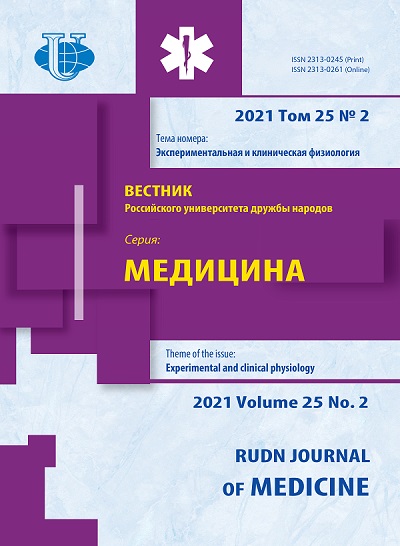Association of BTNL2 gene single nucleotide polymorphism with knee osteoarthritis
- Authors: Sahoo S.S.1, Choudhari O.K.2, Bhadra J.1, Kabi B.C.1
-
Affiliations:
- Vardhman Mahavir Medical College, Safdarjung Hospital
- Vallabhbhai Patel Chest Institute, University of Delhi
- Issue: Vol 25, No 2 (2021): EXPERIMENTAL AND CLINICAL PHYSIOLOGY
- Pages: 89-95
- Section: EXPERIMENTAL PHYSIOLOGY
- URL: https://journals.rudn.ru/medicine/article/view/26554
- DOI: https://doi.org/10.22363/2313-0245-2021-25-2-89-95
Cite item
Full Text
Abstract
Relevance. Osteoarthritis (OA) is one of the chronic debilitating condition mostly seen in the aged population. The etiology behind the OA is multifactorial and the exact cause of the disease often remains uncertain. Apart from the conventional risk factors, there are the speculations of role of genetics playing a pivotal role in the causation of OA. The available literature showed BTNL2 gene polymorphism association with risk of Osteoarthritis whether the same relation is present in north Indian population needs to be elucidated. Objective. To find the association between single nucleotide polymorphism (SNP) (rs10947262) in BTNL2 gene and the susceptibility in knee Osteoarthritis (OA) subjects from northern Indian population. Materials and Methods. Blood samples of 100 patients of knee osteoarthritis and 100 healthy subjects were collected after institutional ethical clearance and participants consent. The BTNL2 gene fragment was amplified using Amplification Refractory Mutation System (ARMS-PCR) with predesigned primers after DNA extraction. The corresponding product bands were identified on the gel electrophoresis for 200 samples and the results were statistically analyzed. Results and Discussion. The genotypic distribution of the SNP followed Hardy-Weinberg Equilibrium. The genotype frequency analysis of the polymorphism was statistically significant (χ2=7.788; P=0.005) with Odd’s Ratio of CT+TT/CC: OR=2.303; P=0.008 revealing association of BTNL2 polymorphism with risk of Knee Osteoarthritis. Conclusion. The SNP (rs10947262) in the BTNL2 gene region is associated with risk of knee osteoarthritis.
Keywords
About the authors
S. S. Sahoo
Vardhman Mahavir Medical College, Safdarjung Hospital
Author for correspondence.
Email: drsubhra71@gmail.com
ORCID iD: 0000-0003-0297-7002
New Delhi, India
O. K. Choudhari
Vallabhbhai Patel Chest Institute, University of Delhi
Email: drsubhra71@gmail.com
ORCID iD: 0000-0001-9993-090X
Delhi, India
J. Bhadra
Vardhman Mahavir Medical College, Safdarjung Hospital
Email: drsubhra71@gmail.com
ORCID iD: 0000-0003-2417-2248
New Delhi, India
B. C. Kabi
Vardhman Mahavir Medical College, Safdarjung Hospital
Email: drsubhra71@gmail.com
ORCID iD: 0000-0002-5611-9225
New Delhi, India
References
- Musculoskeletal conditions. Who.int.2020.Available from: https://www.who.int/news-room/fact-sheets/detail/musculoskeletal-conditions. [Assessed 6th October 2020].
- Tsezou A. Genetics/genomics in osteoarthritis. Osteoarthr Cartil. 2014;22:S4-S5.
- Moos V, Menard J, Sieper J, Sparmann M, Müller B. Association of HLA-DRB1*02 with osteoarthritis in a cohort of 106 patients. Rheumatology. 2002;41(6):666-669.
- Samuels J, Krasnokutsky S, Abramson SB. Osteoarthritis: a tale of three tissues. Bull Hosp Jt Dis. 2008;6(3):244-250.
- Heidari B. Knee osteoarthritis prevalence, risk factors, pathogenesis and features: Part I. Caspian J Intern Med. 2011;2(2):205-212.
- Fernández-Moreno M, Rego I, Carreira-Garcia V, Blanco FJ. Genetics in osteoarthritis. Curr Genomics. 2008;9(8):542-547. doi: 10.2174/138920208786847953
- Nakajima M, Takahashi A, Kou I, Rodriguez-Fontenla C, Gomez-Reino JJ, Furuichi T et al. New sequence variants in HLA class II/III region associated with susceptibility to knee osteoarthritis identified by genome-wide association study. PLoS One. 2010;5(3):e9723.
- Horton R, Wilming L, Rand V, Lovering RC, Bruford EA, Khodiyar VK et al. Gene map of the extended human MHC. Nat Rev Genet. 2004;5(12):889-899.
- Osteoarthritis (OA). CDC 2020. Available from: https://www.cdc.gov/arthritis/basics/osteoarthritis.htm. [Assessed 7th December 2020].
- Symmons D, Mathers C, Pfleger B. Global Burden of Osteoarthritis in year 2000: Global burden of disease 2000 study. World health report. 2002;5:2.
- Reynard L, Barter M. A year in review: genetics, genomics, epigenetics. Osteoarthr Cartil. 2019;28(3):S22.
- Iraj Salehi-Abari. 2016 ACR Revised Criteria for Early Diagnosis of Knee Osteoarthritis. Autoimmune Dis Ther Approaches. 2016;3:118.
- ACR Diagnostic Guidelines. Johns Hopkins Arthritis Center. 2020. Available from:https://www.hopkinsarthritis.org/physician-corner/education/arthritis-education-diagnostic-guidelines/#class_knee. [Assessed 18th October 2020].
- Wetterholm M, Turkiewicz A, Stigmar K, Hubertsson J, Englund M. The rate of joint replacement in osteoarthritis depends on the patient’s socioeconomic status. Acta Orthop. 2016;87(3):245-251. doi: 10.3109/17453674.2016.1161451
- Valdes AM, Styrkarsdottir U, Doherty M, Morris DL, Mangino M, Tamm A et al. Large scale replication study of the association between HLA class II/BTNL2 variants and osteoarthritis of the knee in european descent populations. PLoS One. 2011;6:e23371.
- Sun W, Min H, Zhao L. Association of BTNL2 single nucleotide polymorphisms with knee osteoarthritis susceptibility. Int J Clin Exp Pathol. 2019;12(10):3921-3927
- Shi D, Zheng Q, Chen D, Zhu L, Qin A, Fan J et al. Association of single nucleotide polymorphisms in HLA class II/III region with knee osteoarthritis. Osteoarthritis Cartilage. 2010;18(11),1454-7.
- Maini RN, Taylor PC. Anti-cytokine therapy for rheumatoid arthritis. Annu Rev Med. 2000;51:207-29. doi: 10.1146/annurev.med.51.1.207.
- Grunke M, Schulze-Koops H. Successful treatment of inflammatory knee osteoarthritis with tumor necrosis factor blockade. Ann Rheum Dis. 2006; 65:555-556
- Nguyen T, Liu XK, Zhang Y, Dong C. BTNL2, a butyrophilin-like molecule that functions to inhibit T cell activation. J Immunol. 2006;176(12):7354-7360.
- Ulvestad E, Williams K, Bø L, Trapp B, Antel J, Mørk S. HLA class II molecules (HLA-DR, -DP, -DQ) on cells in the human CNS studied in situ and in vitro. Immunology. 1994;82(4):535-541.
- Revell PA, Mayston V, Lalor P, Mapp P. The synovial membrane in osteoarthritis: a histological study including characterization of the cellular infiltrate present in inflammatory osteoarthritis using monoclonal antibodies. Ann Rheum Dis. 1988;47:300-307.
- Sakkas LI, Johanson NA, Scanzello CR, Platsoucas CD. Interleukin-12 is expressed by infiltrating macrophages and synovial lining cells in rheumatoid arthritis and osteoarthritis. Cell Immunol. 1998;188:105-110.
- Goldring MB, Sandell LJ, Stephenson ML, Krane SM. Immune interferon suppresses levels of procollagen mRNA and type II collagen synthesis in cultured human articular and costal chondrocytes. J Biol Chem. 1986;261:9049-9055.
- Schlaak JF, Schwarting A, Knolle P, Meyer zum Buschenfelde KH, Mayet W. Effects of Th1 and Th2 cytokines on cytokine production and ICAM-1 expression on synovial fibroblasts. Ann Rheum Dis. 1995;54:560-565.
- Blades MC, Ingegnoli F, Wheller SK, Manzo A, Wahid S, Panayi GS et al. Stromal cell-derived factor 1 (CXCL12) induces monocyte migration into human synovium transplanted onto SCID mice. Arthritis Rheum. 2002;46:824-836.
















